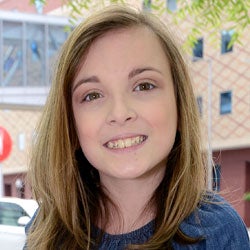Grace Holder
January 2, 2019Spastic Diplegia, Gait and Motion Analysis Lab
Grace Holder When Grace Holder was born on November 6, 2002, she was just like her twin sister, Georgia. But about six months later, Grace began exhibiting questionable symptoms. “She wasn’t achieving basic milestones like her sister, like pulling up on the side of the crib,” Grace’s mother, Lee, said. “I also noticed by the way she was holding her hands that it seemed as if something was wrong.” When Grace was just nine months old, the family traveled from their home in Corinth, Mississippi, to a hospital in Memphis. After three months there of testing and waiting, Grace was officially diagnosed with spastic diplegia, a form of cerebral palsy marked by tense muscles and spasms, with leg muscles in particular tending to be extremely tight. In the first few years after diagnosis, Lee took Grace to a series of doctors. Wanting more aggressive and cohesive treatment, they eventually visited Children’s of Alabama. “I heard about Dr. Drew Davis, so I made an appointment with him,” Lee said. “When we met Dr. Davis, he was so thorough and clear on what could be done to help Grace and the options that we had. It was clear from that very first appointment that he has a heart for helping children.” Davis provided a treatment plan for Grace that included Botox injections and enrollment in an intensive therapy program. Grace also had a surgical procedure done on her spine called a rhizotomy, which works to provide relief for muscle spasms in the legs. “The surgery helped for quite a while, but as she kept growing it became more difficult for her to walk again,” Lee said. In December 2015, Davis and pediatric orthopedic surgeon Joseph Khoury, M.D., sent Grace to Children’s Gait and Motion Analysis Lab, which uses smart software for gait and motion analysis. During the comprehensive analysis, sensors are placed on the child’s skin to capture data which creates a computerized image of the child’s skeletal structure. Data is analyzed to determine how joints are actually working and which muscles the child is using. Davis and Khoury used the information from Grace’s analysis to plan her next surgery to lengthen the tendons in each leg. “Because of the gait analysis, the doctors knew exactly what tendons needed lengthening,” Lee said. “Now, thanks to the analysis and surgery, Grace is doing great. Every day she walks with more of a normal gait pattern than the day before. We see improvement in her every day.”







